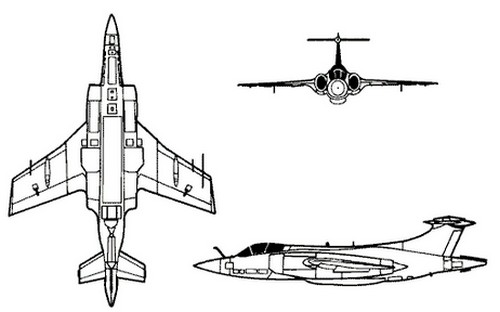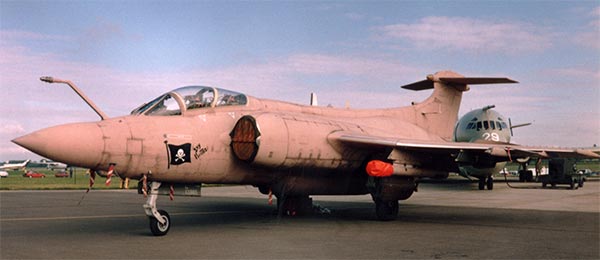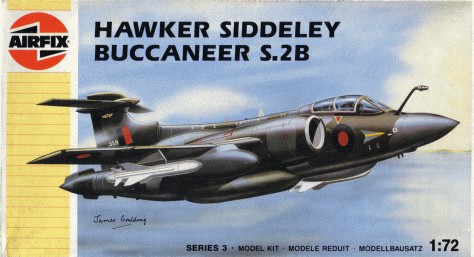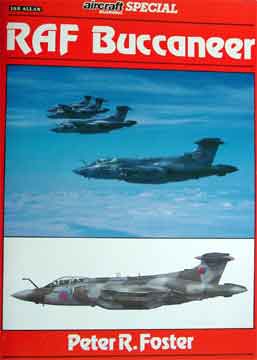Airfix kits

Buccaneer models in 1/72 scale
page 3
page 4
page 5

Development of the Buccaneer for the British Royal Navy Fleet Air Arm (FAA) as a low level fast strike attack bomber began 1953 at the Blackburn company as per Naval Staff Requirement 39. The Royal Navy carriers required such a type during the Cold War. The first flight of the Blackburn NA 39 prototype was end April 1958. It was designed to fly at low level and had a strong airframe and two man crew of pilot and navigator. The bomb load was carried inside on a rotating bomb bay door. It had a nuclear strike capability. In order to have better low speed handling characteristics, it featured unique "blown boundary layer" wing and tailplane slots. The engine was a smaller De Havilland Gyron junior (the original Gyron being developed for the Avro Arrow). Some 20 pre-production NA 39 aircraft were used to finalize the production airframe and differed a bit between each such as in nose, tail fairings and air brakes. The outboard wing sections eventually got many vortex generators but this caused drag and reduced range. Some NA 39 test aircraft were lost.
The first operational Buccaneer version was the S.Mk.1 later designated S.1 with small intakes for the pair of DH Gyron junior engines and a shortened exhaust pipe as compared to the NA 39. It also got bullet fairings on top of the vertical stabilizer. The outher wings could be automatically folded for storage at Royal Navy carriers. The S.1 began operational FAA naval use mid 1962 flying from carriers such as HMS Victorious and HMS Eagle and some 40 were built. It proved to be underpowered and had a small range, requiring often in flight refuelling by Scimitar jets fitted as tanker aircraft. (Blackburn Aircraft in 1963 became part of the Hawker Siddeley Group of companies).
The Buccaneer was developed further with the S.2 obtaining 40% more power through a pair of Spey RB.168 engines and these needed larger air intakes. Also some electronical equipment boxes were fitted at extended wing tips. The first S.2 flight was in May 1963. The FAA obtained some 84 S.2 aircraft and they performed as required.
In 1962 also the South African Air Force (SAAF) ordered 16 Buccaneers S.2 designated mk. S.50 with first delivery October 1965. These SAAF aircraft were also fitted initially with BS.605 rockets to assist take-off and also a beefed up undercarriage whereas the automatic wing folding system was removed to save weight. (it turned out that the rockets were not needed and thus were no longer fitted). Later on, an arms embargo blocked an additional 20 aircraft SAAF order. The SAAF aircraft could fire the AS-30 missiles and be fitted with rocket pods. They could also be fitted with longer slipper tanks. The last Buccaneer flew until 1991 with the SAAF.
In the late 1960s, the S.2 type also was chosen for the Royal Air Force (RAF) as the intended TSR 2 was eventually stopped and F-111K for the RAF never materialized. The first RAF S.2b Buccaneers arrived in 1969 with some 46 new aircraft and it seems these were structurally beefed up to fly low over land. A bulged bomb door could be fitted to also accommodate inside an extra fuel tank. These RAF aircraft could also fire Martel missiles.
The FAA also obtained the S.2 and these were later upgraded to S.2d capable of firing Martel missiles. The FAA also reworked some aircraft to S.2c standard. The FAA S.1 aircraft were phased out rather abruptly end 1970 after a crash. As the Royal Navy got fewer aircraft carriers some 62 remaining FAA S.2 aircraft were transferred to the RAF to fly from land bases and reworked to S.2a standard. Some aircraft were upgraded to S.2b standard capable of firing Martel missiles. The FAA did no longer use the Buccaneer, now it was only flown by the RAF (and still the SAAF).
The RAF S.2 aircraft were upgraded over their service life with ECM ALQ-101 and chaff systems and could fire Sidewinder missiles for self defense. From 1986, these RAF Buccaneers could fire Sea Eagle missiles in stead of the Martel.
The Buccaneer S.2 versions proved to be a capable, rugged and strong aircraft for its tasks. Some flew during the first Gulf War in a desert pink paint scheme.

photo made at the IAT
Overall some 210 Buccaneers were manufactured and the type was operated by the FAA, RAF and SAAF.
The S.2 top speed was about Mach 0.875 with an over 2,000 miles range with "slipper tanks".
Now on to 1/72 scale kits...
[1] Airfix came in 1960 with the very first kit #384 of the Buccaneer, and this kit is very simple. On the box is stated Mk.1 but actually it is not a S.1 but an early pre-production NA 39. Typical of the NA 39 are the long exhaust pipes, the lack of the area ruling fairings on top of the horizontal stabilizer and the small intakes.

This NA39 kit is discussed on page 4....
[2] In 1972 FROG came with a Buccaneer S.2a / mk.50 kit #F238 in 1/72. I never bought it but it also had SAAF decals. NOVO also released this one later on.

[3] In 1974 also Matchbox Lesney released a Buccaneer S.2b kit #PK-106 with a RAF configuration. I made one decades ago and remember I was quite happy with it. I think it had panel lines as "trenches" but when puttied looked quite good.

[4] Airfix came in 1989 with a new kit for a Buccaneer S.2B. It appeared in various boxes over the years. I had Airfix S.2B kit #03055 intended
for a RAF version.

The kit has the correct S.2B larger intakes and was a new kit as compared with their old "Mk.1" NA 39. This kit will be discussed on page 2....
Another kit was converted to a Buccaneer S.1. This kit is discussed on page 3....
Airfix released many years later in 2010 in a nice looking kit #A04049, but it has the basic parts as the 1980s kit mould though with some new extra parts and better decals (including SAAF).

[5] Airfix came end 2019 with a brand new state of the art kit #A06021 for a 1/72 Buccaneer S.2C.

(It appears that the model is also prepared for a RAF kit as it has some structural re-enforcements with some small externally visible plates and strakes on the airframe. These are typical for thee updated RAF machines which also Airfix announced to release end 2020 with RAF schemes).
![]()
On to next
[Page 2 ].....
kit review modelling report
kit review modelling report
kit review modelling report
kit review modelling report
kit review modelling report
kit review modelling report
kit review modelling report
kit review modelling report
kit review modelling report
kit review modelling report
http://www.thunder-and-lightnings.co.uk/buccaneer/index.html
http://www.hunterteam.com/buccaneer_tech_specs.htm
BOOKS:
(1)
RAF Buccaneer, Peter Foster, Ian Allan special;
(2) Scale Aircraft Modelling magazine, "Aircraft
in Detail" series by Paul Jackson (volume unknown);
(3) Buccaneer S.1, From the Cockpit no.6, Michael Doust, AdHoc publications, 2007.
(4) Air international magazine, Vol.36 no.3, March 1994.

(c) Copyright Meindert "designer"/ All rights reserved. Your comments are welcomed by webmaster
Created this page
December 23, 2005;
Update Autumn 2020